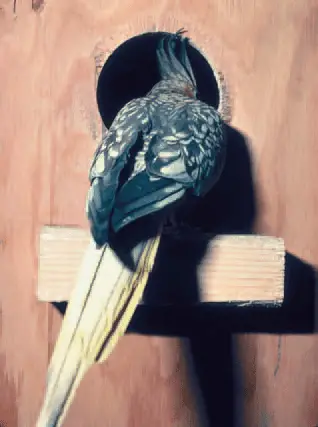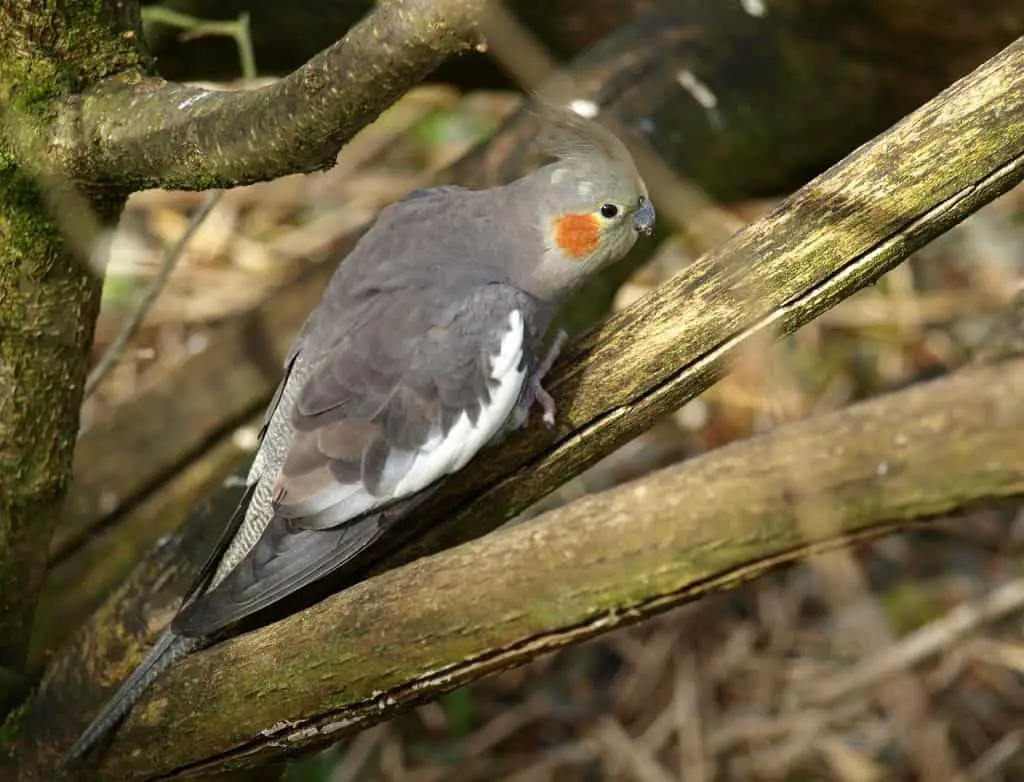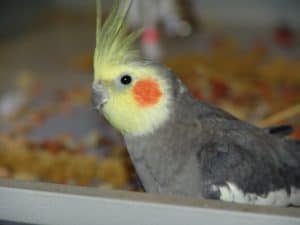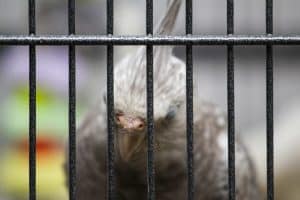Cockatiel heart wings: Why is my bird making them?
Cockatiel heart wings or cockatiels with heart-shaped wings are normal male cockatiel behavior. The male cockatiel displays his heart-shaped wings or cockatiel heart wings as a sign of masculinity and impresses the female cockatiel. Also known as “the big chest.” A male cockatiel keeps his wings slightly away from his sides while sticking out his chest. From the rear, the wing’s form resembles a heart shape.
Why do cockatiels do heart wings?
Cockatiels do heart wings as a sign of affection and happiness. This behavior is often seen in pet cockatiels when they are interacting with their owners or other birds.
When a cockatiel does heart wings, it spreads its wings out in a heart shape, with the feathers slightly fluffed up. This is a display of excitement and pleasure, and is often accompanied by chirping, singing, and other vocalizations.
Heart wings can also be a sign of mating behavior in cockatiels. Male cockatiels may do heart wings to court a female, or a pair of bonded cockatiels may do heart wings as part of their pair-bonding behavior.
Overall, heart wings in cockatiels are a positive and joyful expression of their emotions, and can be a sign that they are feeling happy and content in their environment.
Do female cockatiels do heart wings?
Yes, female cockatiels can also do heart wings. Both male and female cockatiels can display this behavior as a sign of happiness and affection. Heart wings are not gender-specific, and both male and female birds may do it to show their feelings. However, as I mentioned earlier, heart wings can also be a part of mating behavior in cockatiels, and in that case, it is more common for the male to do heart wings as part of his courtship display.
Do cockatiels know you love them?
While it’s difficult to say if cockatiels can understand the concept of love, they can certainly recognize and respond to positive emotions and behaviors from their human companions. Cockatiels often show affection to their humans through cuddling, preening, and vocalizing. As such, providing your cockatiel with regular attention, care, and affection can help strengthen your bond with them and make them feel loved and appreciated.
Cockatiels have some unique body language cues that can indicate if they are unhappy in their relationship with you. They may have claws extended and beaks open to bite, if they feel threatened. Whilst they may have bright eyes and display tail fanning and cockatiel heart wings when they are trying to impress you.
What do cockatiels love the most?
Cockatiels are an omnivorous bird that deserves a few different foods in their diet for optimal health. Some of their favorite snacks include seeds, nuts, fruits, veggies, pasta, bread – really anything carbohydrate based. You can also give them small amounts of protein like eggs, chicken or meat to switch things up and keep them healthy!
Cockatiels love to chew things like sticks and bark. You can also give them toys specially made for chewing.
- Challenges Your Parrot Mentally & Physically --- Toys are a necessity for parrots. They provide essential physical activity so that our intelligent feathered pets stay healthy. Bird Chewing Toy by SunGrow provides opportunities for parrots in the cage which they undertake when living in their native habitat. There are several multi-colored blocks in this single toy to make your bird active. These blocks are arranged in multiple layers to climb and explore.
- Entertaining Toy For Your Birds --- A parrot with nothing to do is a prime candidate for behavioral problems. Some parrots tend to be more disruptive during certain times of the year, usually during their breeding period. SunGrows bird chewing and preening toy is a perfect companion to keep your parrots busy, less disruptive and have more fun hours which keep them active mentally.
- Edible Chew Toy --- It is important for the avian species that we keep something for them to chew on. In their native habitat, they engage in chiseling holes and tearing up branches. This is something innate to them. The wooden blocks chew toy by SunGrow is made from wood and cotton rope. So when they nudge on to their toy, it would keep them content. So if you dont spot your green cheek outside playing, just hover a little inside. They might be hiding amongst the blocks and savoring them.
- Right Size For Your Bird --- The Bird Chewing Toy by SunGrow comes with a standard size of 40cm (15.7) x 10cm (3.9) and fits well in your beloved feathered pets cage. The included metal buckle holds this toy in place. Its crunch potential is ideal for small parrots and medium-sized, conure-sized birds. It is suggested for macaws, African greys, Cockatiels, Cockatoos, Budgies, Lovebirds, pigeons, and a variety of Amazon parrots as well.
How do cockatiels flirt?
Cockatiels flirt through a combination of visual and vocal cues, such as feather puffing, head swaying, singing, and chirping. The female may respond with head bobbing, wing lowering, and clicking sounds. Being social creatures, cockatiels require interaction outside of their cage, so pet owners should provide plenty of attention and opportunities for socialization.

What does it mean when a cockatiel’s head feathers are up?
The position of a cockatiel’s crest feathers can reveal its disposition. Straight-up crest feathers indicate the cockatiel is startled or intensely interested. A defensive cockatiel will flatten out its crest feathers close to its head, and it may become even more agitated if it hisses.
Can you kiss cockatiels?
Most definitely not! Even if you take the necessary precautions and clean both yourself and your bird properly, it is still harmful to kiss them. A human’s saliva has thousands of different types of bacteria that birds are susceptible to because they don’t have the immunity to fight against it.
What is a cockatiels favorite food?
A well-rounded diet for a cockatiel includes commercial birdseed, pelleted food, vegetables, fruit and the occasional treat. For most of their diet, offer them a mix of 75% pellets and 25% seeds. Every other day, give them fresh fruit like berries, melon, papaya or kiwi as a special treat.
- COCKATIEL FOOD: Large variety of seeds, grains and vegetables in every bowl to provide the balanced variety of nutrients that cockatiels need with great taste theyll love.
- ADVANCED NUTRITION: Contains vitamins, minerals and Omega-3 fatty acids to support healthy skin and shiny feathers.
- IMPORTANT VARIETY: Unique mix of millet, oat groats, safflower seeds, sunflower seeds, cracked corn, peanuts and more creates an irresistible blend to replicate diets found in a natural habitat and encourage foraging behaviors.
- DAILY DIET: Feed cockatiels 2 to 4 tablespoons daily per bird.
- WILD HARVEST BRAND: Offers a full assortment of nutritional and interactive engagement products.
Can cockatiels eat bananas?
Fruits are enjoyable for cockatiels, and they enjoy them. On the other hand, they can be high in sugar and some vitamins, but poor in nutrients. As a result, you should be cautious with them and avoid feeding your birds too much fruit. A cockatiel that eats too many fruits may become overweight due to their high calorie content.
Your Bird’s Body Language
Cockatiel heart wings are just one of many types of cockatiel body language. Developing a rapport with your pet bird is key to having a healthy and thriving relationship. Because they are emotional creatures, it’s important to be in tune with their moods and behaviors.
Birds communicate in a variety of ways. Despite the fact that you believe they just squawk when they have something to say, birds use their body language with great skill. Here are some of the ways your bird may communicate with you:
Eyes
Birds have the ability to control the size of their pupils, and sometimes you may notice your bird’s pupils rapidly enlarge or shrink (a behavior called flashing or pinning). This is usually a sign that the bird is focused on something, and they may be very interested in it, about to do something like talk or bite, or they are frightened or angry. There are other clues in their body language that can help you determine what exactly is causing this reaction.
Feathers
When a bird ruffles his feathers, this can signal various things such as preening, being cold, or simply taking a break. If you see that your bird’s feathers are sticking out and he is fanning his tail while also holding out his wings, this generally indicates aggression.
Wings
In addition to needing a bit of exercise, your bird may communicate his feelings to you through wing movement like cockatiel heart wings. If he’s flapping his wings, it usually means he either wants your attention or is feeling joyful. On the other hand, if he’s flipping them, he’s probably displeased about something. Lastly, if his wings are drooping, it could be an indication that he’s tired or not feeling well.
- Bird Baths: suitable for Crested Starlings, bird baths are suitable for small birds, budgies, lovebirds, conures, finch canaries, small parrots and parakeets, etc.
- High-quality material The bird-shaped bathtub is made of transparent acrylic material, which has good transparency, toughness and lightness, strong, non-toxic, long-lasting, and no strange plastic/chemical smell.
- Easy to install There are two hooks in both directions. You can install the hooks in two positions to hang on the inside or outside of the cage. It is very convenient to use.
- Can provide a good small bathtub for your bird to help keep your bird clean and healthy
- Size; suitable for small and medium-sized parrots-please check the size carefully before buying, the small size is 5.1x5.1x4.3inches, the large size is: 6.3*6.3*6.3 inches
Tail
Despite the fact that it’s typically dogs pictured with wagging tails, pet birds may communicate a great deal with theirs also. The majority of tail flipping and wagging is an indication of joy, while tail fanning is a sign of aggression. If your bird’s tail is flapping back and forth, he might be out of breath.
Legs
This might be one of the first things you notice your bird doing. He will lift up one leg and wing, then put it down and do the same with the other leg and wing. This little jig indicates that your bird is in excellent condition.
Beak
In addition to vocalizing, your bird’s beak may be used to communicate in a variety of ways. When your bird is resting and grinding his beak, he is usually quite pleased. It might indicate a greeting if done once, and it could alert you if it’s repeated. If your pet regurgitates his food at you, this is one sign that may alarm you. Don’t worry! This is proof of love and affection between mates, which they do on a regular basis for each other. You and your bird have an unique relationship.






